Discovering the Isle of Canna – and planning your trip
The Isle of Canna – an inspiring and revitalising retreat
After all the years of admiring the view of The Small Isles from Arisaig, it seemed it was high time to start exploring them more. Admittedly, you can’t see the Isle of Canna from Arisaig as it hides behind the Isle of Rum, but it ticked the boxes I was looking for this time round – somewhere easy to explore in a short time and puffins!
The Isle of Canna is truly an unspoiled Scottish gem. Its lack of noise, light and air pollution, leisurely pace of life, gorgeous beaches and range of walks and views make it one to add to your list of top places to visit in Scotland. If sustainable living is a priority for you, move it higher up your list!
If you’re already visiting Arisaig or nearby, Canna can be added on to your holiday or it can be part of a day trip during your stay. We stayed on the island but you can still visit a few of the places covered below if you’re just doing the Wednesday or Saturday CalMac ferry from Mallaig.

If you’re looking for a digital detox, Canna is ideal! We had no phone signal, and the only Wi-Fi accessible was at the island cafe but that also turned out to be a bit hit-and-miss for us. If you’re staying for a longer time, you could probably also hang out next to the ferry when it’s in to catch up.
Disclosure: When you make a purchase through some links on this post, I may earn commission from partners. (This does not include any of the accommodation or businesses on the Isle of Canna or in Mallaig or Arisaig.) This helps me to build a site full of information and tips and to bring you more great posts!
An overview of Canna
The island is just 4.3 miles long and 1 mile wide with most of the sights being located on the eastern side. Sanday is a tidal island to the south of Canna and is connected by sandbanks at low tide and only accessible by the new bridge at other times.
Although the two are considered one community and owned by the National Trust for Scotland (NTS), Sanday still has crofts unlike Canna, which is run as one farming unit by the NTS. They were gifted to the Trust in 1981 by John Lorne Campbell who bought the islands in 1938.
Canna and Sanday form part of both the Small Isles and the Inner Hebrides and fall under the administration of Highland Council. The population is only 15 although in the summer there may be temporary residents doing both seasonal and voluntary work.
The island’s Gaelic name is Eilean Chanaigh although its origin is believed to go much further back and precede the Norse period. The origin of the island itself goes back to a series of volcanic eruptions and basalt lava flows around 60 million years ago and you will see basalt cliffs as you tour the island.
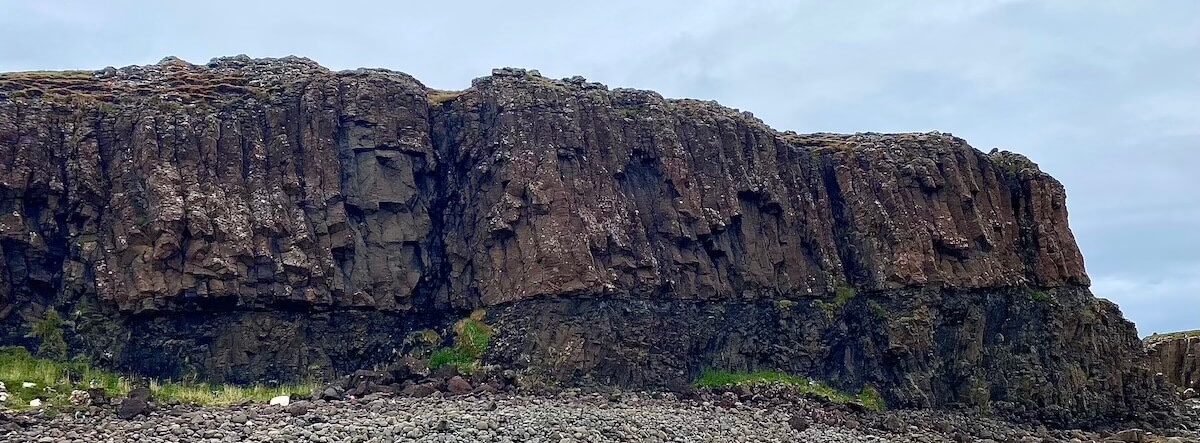
Canna has a rich history which can’t be covered here but evidence of human settlement goes back to the late stone age and the Celtic crosses at A’Chill are dated to the 8th to 9th centuries. Since then, the island saw the arrival of the Vikings in the 9th century, Scottish rule returning, the Highland Clearances and many other significant events along the way.
Getting to the Isle of Canna
Unless you have your own boat, to get to Canna, you take the CalMac ferry from Mallaig. From April to mid October, this runs on Friday, Monday, Wednesday and Saturday. The Monday ferry also stops at the Isle of Eigg and all of them stop at Rum.
The Wednesday ferry docks at Canna Pier for a couple of hours and the early ferry on Saturday allows you seven hours so this is the best one to take for a day trip. You can check all sailing times at the CalMac website.
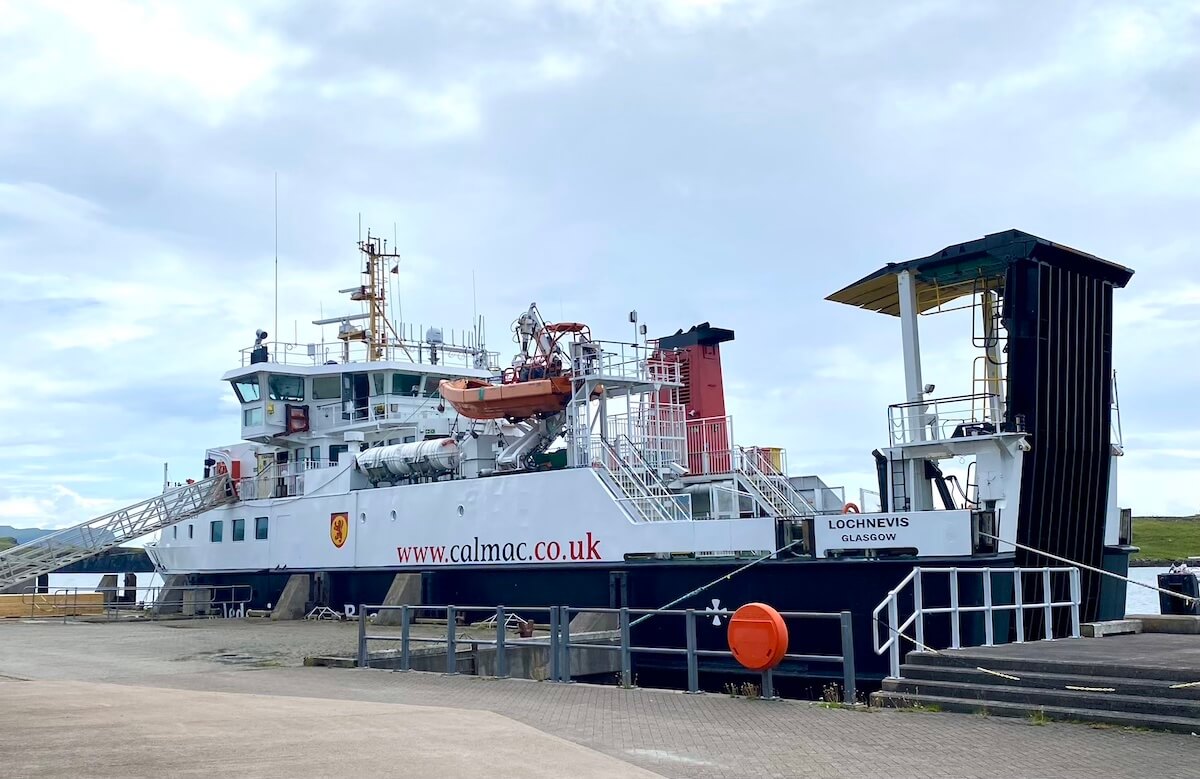
An adult return is £11.80 and it’s half-fare for children up to 15. Bikes and kayaks go free but should be booked in advance and are not allowed on the Saturday ferry. Dogs go free. It’s recommended to book in advance at the link above.
Cars aren’t allowed on Canna island without a permit but you can park your car at the West Bay Car Park next to Mallaig Community Centre. There is an ‘invitation to pay’ at this car park and making a payment supports the work of The Road to the Isles Facilities Group (a community charity) to continue providing such facilities and maintain them. This means you’ll not be fined if you don’t pay but your donation will be very much appreciated.
If your journey isn’t already starting in Arisaig or Mallaig, you can get there by taking the direct train from Glasgow or other routes in Scotland with a change in Fort William. There is also a bus service with Sheil Buses from Fort William.
Alternatively, by car, take the A830 from Fort William or coming from the north east, you could cross the bridge to the Isle of Skye and take the ferry from Armadale to Mallaig.

For a bit more freedom, boats can be chartered from several locations along the West Coast and the islands. Arisaig Marine, Western Isles Cruises and Minch Adventures all offer charter services. There are ten mooring slots available at Canna as well as anchorage. It’s advisable to book ahead.
Once on the island, your only option is to get around by foot or bike (you’ll need to bring your own.)
📖 Buy a digital version of this guide to help you during your visit. Includes maps and checklists.
What to see and do on Canna
Churches on Canna and Sanday
As you approach the island, the first thing you’ll notice is the Church of St Edward on Sanday and as you come into the harbour, you’ll see the Rhu church. In fact, there are three churches all within a short distance, but only one is currently in use.
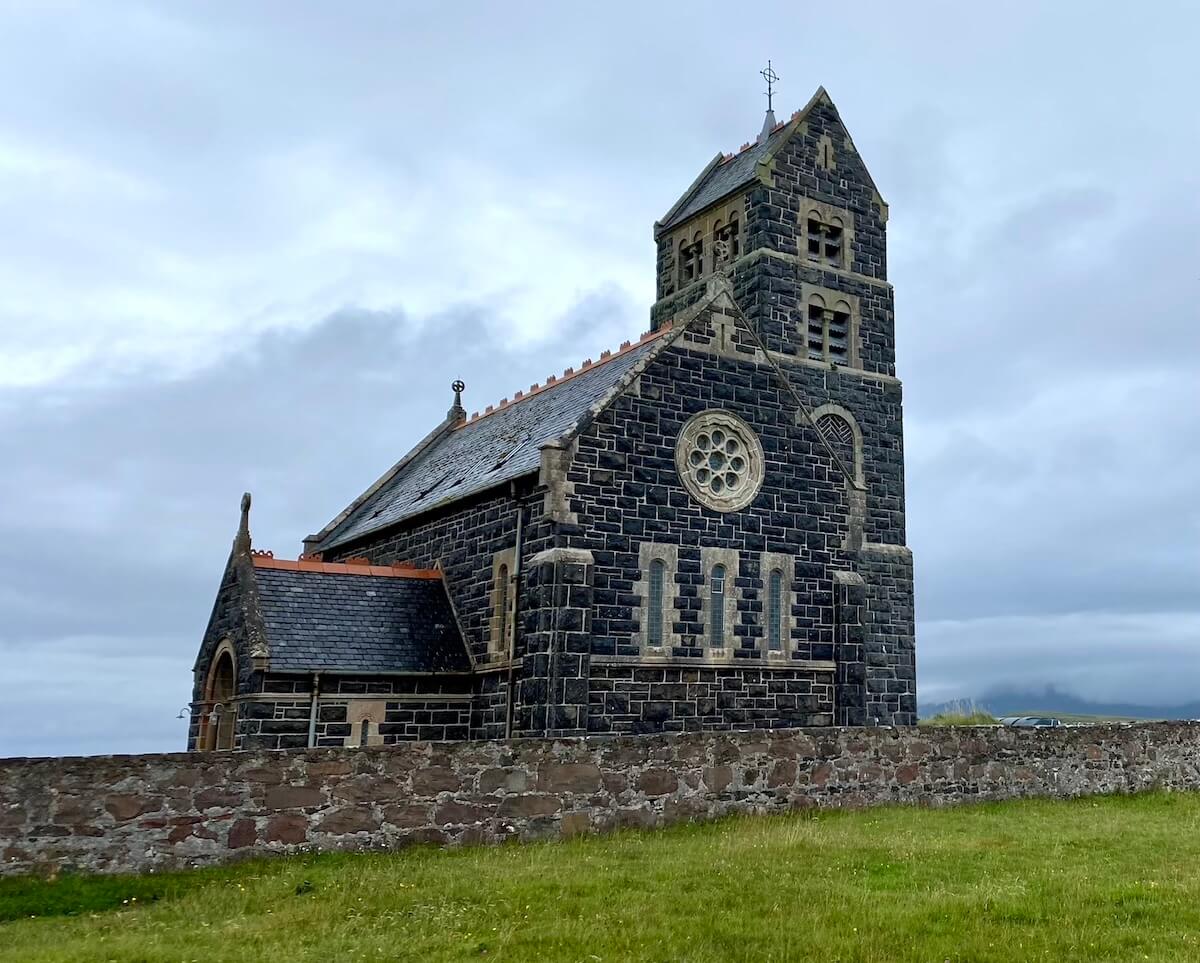
St Edward’s was built in 1890 and was a catholic church. It has also served other purposes over the years, such as a hostel, but has proved too difficult to maintain. You can walk around the church but the gates are locked.
Rhu Church, close to the pier, was built in 1913 and was a Presbyterian place of worship. This is also locked but worth a walk around the outside on your way to or from the ferry.
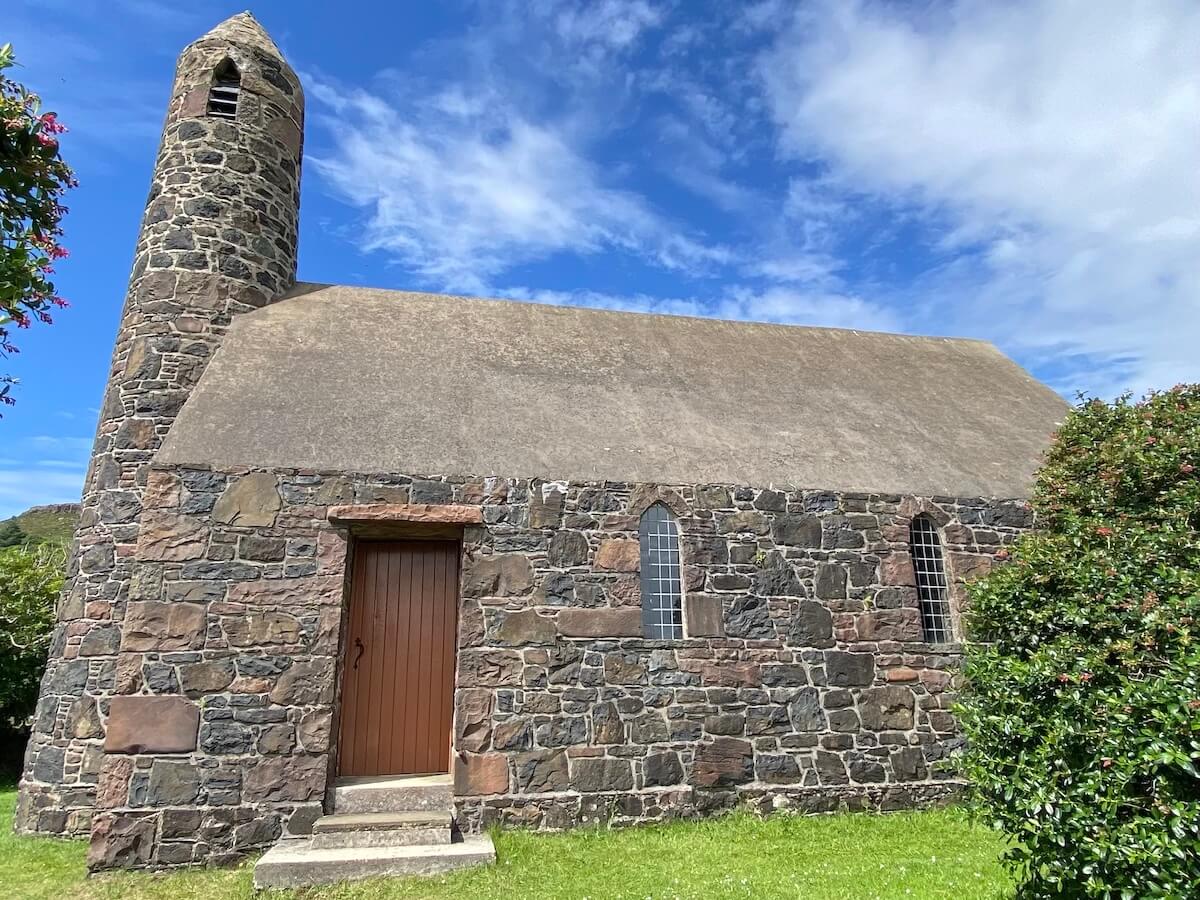
Finally, St Columba’s Catholic Church is the oldest of the churches on Canna, built in the 18th century, yet the only one currently functioning. It also served as a post office for some years. It’s a simple building and you can go inside but there is not much more to see. The stained glass windows are its main feature and particularly beautiful when the sun is shining on them.
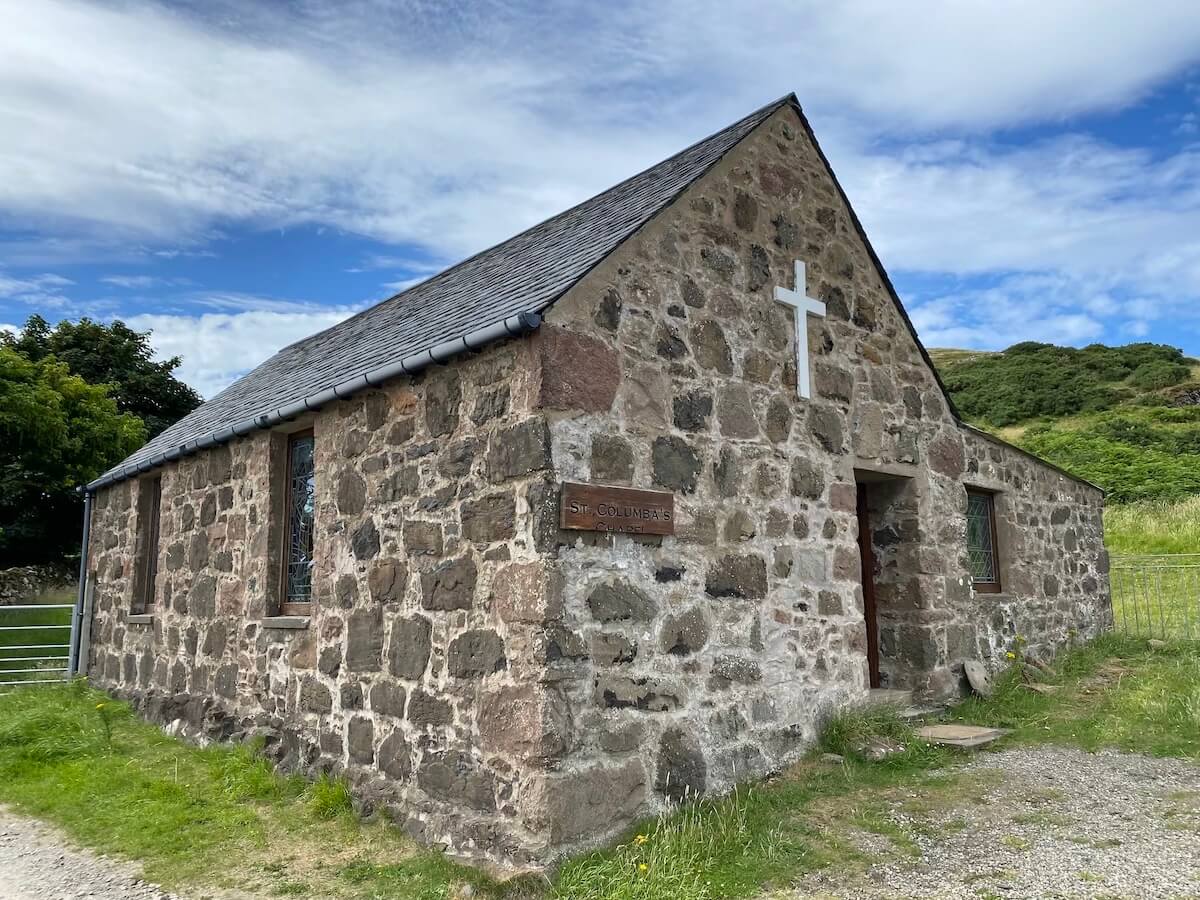
A’Chill, Celtic Cross and the Punishment Stone
A’Chill was once an important village on the Isle of Canna with a long history. On the hill above the coastal road stands an ancient Christian cross dating back to the 7th or 9th century and most likely linked to St Columba. Look closely at the intricate Celtic designs carved into it.
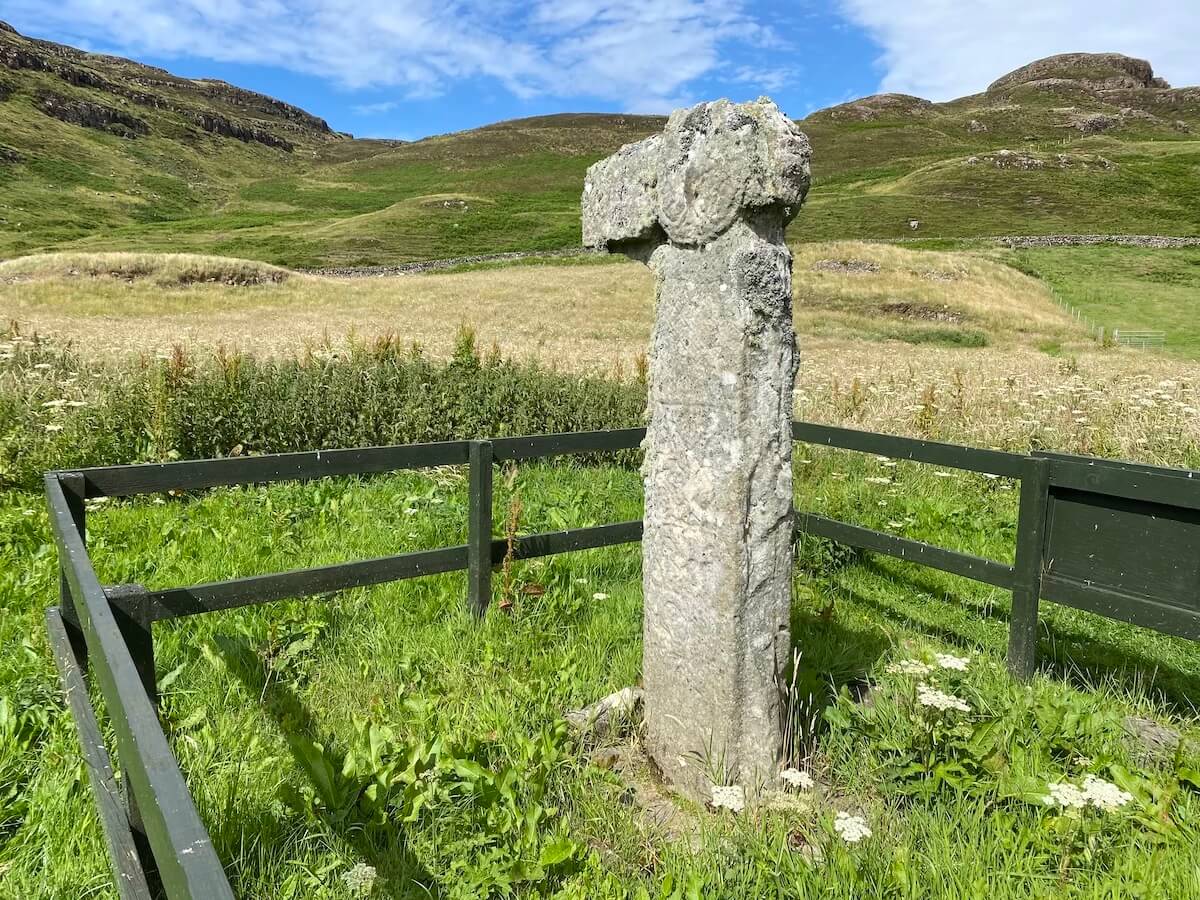
Nearby is a standing stone known as the ‘punishment stone’, where transgressors had their thumbs wedged into a hole as a form of public punishment or humiliation.
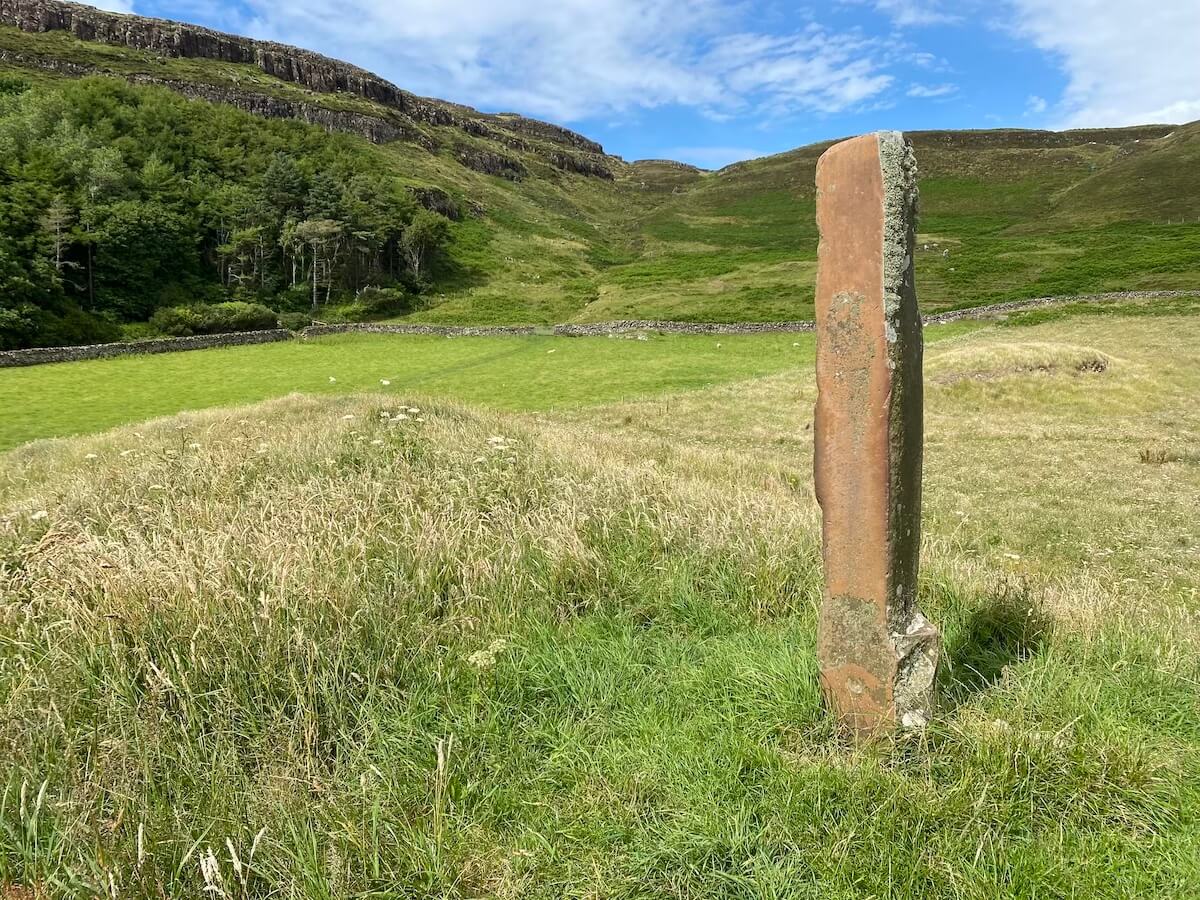
Sadly, the village of A’Chill that once stood here and its inhabitants fell victim to the Highland Clearances.
If you arrived by a different route, go back down to the coast road through the gate, which will take you into the woods where John Lorne Campbell is buried. The path starts and ends next to St Columba Church.
If you go to A’Chill through the woodlands and then want a longer walk, head east across the field, join the road down and look out for a gate on your left that will take you onto the path behind Canna House and Saturnino’s Path.
Puffin Stack
If you’re visiting between April and August, you shouldn’t miss a walk to the Puffin Stacks on Sanday. You will need a pair of binoculars to see them well though as the stack is around 40 feet or so away from the land. I only had my phone with me so unfortunately, I have no close-ups of the puffins.

To get there, cross the bridge to Sanday island, follow the rocky track up past St Edward’s Church and through the wind farm, then follow the stone fence on your left until the gate. Turn left through the gate and walk eastwards (If you’re facing the shore, then go left, not right.)
Eventually you’ll see a gate on your right and a puffin sign. Go through the gate and look out for the orange puffin signs to follow the track to the coast opposite the sea stack.
It’s an easy enough walk but it’s quite boggy in parts so you really need waterproof boots.
We took a picnic with us and sat on the cliff for a while watching the puffins and looking out for other birds. Even if you’re not visiting during puffin season, it’s still an impressive view.
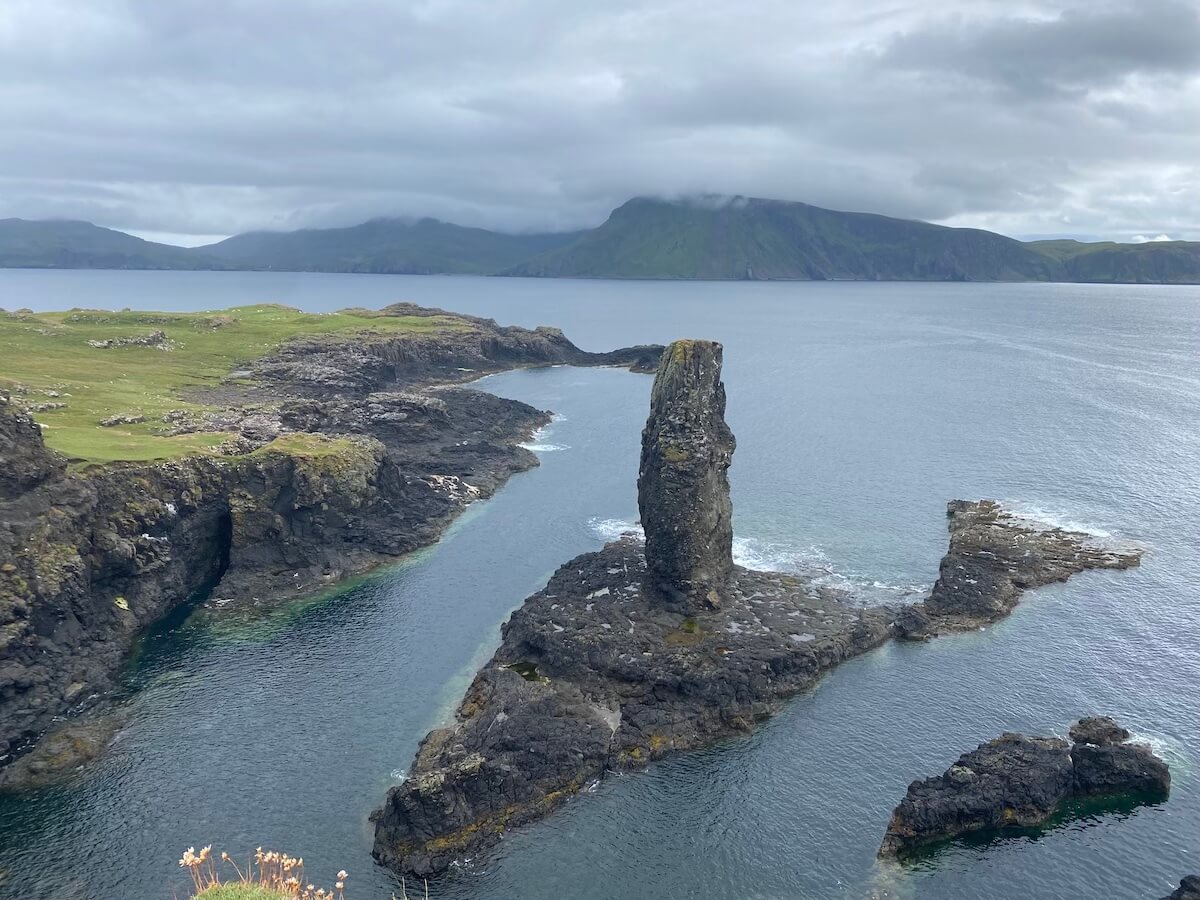
From there you could go either walk across to the lighthouse at the tip of Sanday or continue back the same path and from the church walk back along the coast or after the red house on the left, cut through the field to the beach. Continue to the end of the beach and follow the path to get back onto the bridge.
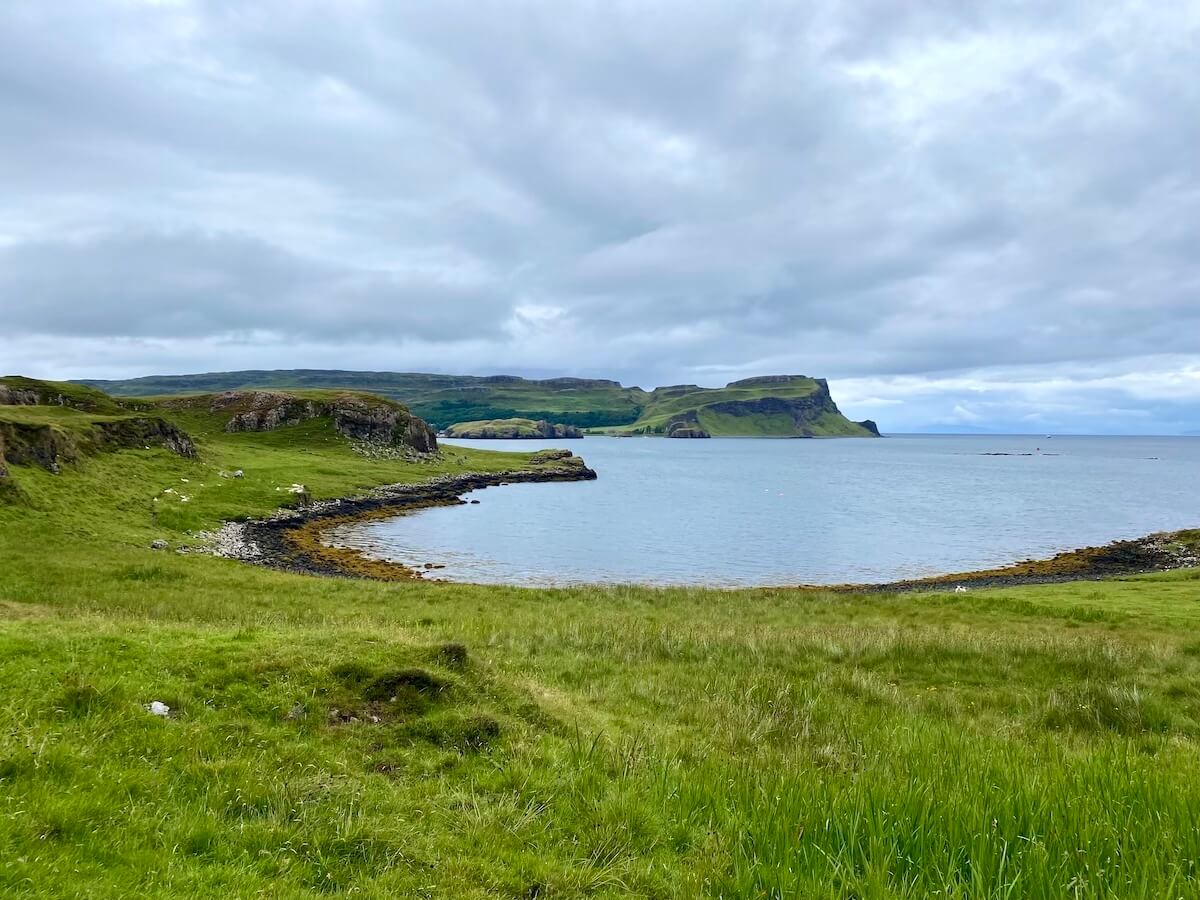
For a different route, you can also walk back round the Western side of Sanday which has some impressive scenery. We did a detour round that way and the walk along the cliff tops is much easier, and safer, than trying to walk along the coast.
Wind farm
You’ll probably spot the wind farm comprising six small wind turbines as you come into Canna Bay. There was certainly plenty wind to keep them spinning when we were there!
Sanday Beach
Just past the bridge on the left is the beautiful Sanday beach resplendent with its white sand and turquoise sea. It’s a lovely sheltered spot for a swim or a picnic. Look out for the path between the end of the bridge and the memorial. (You’ll find a painted cat here too.)

Canna House
Built in the mid-19th century, Canna House became the home of John Lorne Campbell and Margaret Fay Shaw. Due to their dedication to preserving Gaelic songs, oral histories, and traditions, it is renowned for housing one of the country’s most significant collections of Gaelic manuscripts and folklore material.
It contains an extensive library and old photographs and recordings providing a glimpse into the lives and stories of the Gaelic-speaking communities of the Highlands and Islands.
Unfortunately, Canna House is not open to visitors now. The gardens are also currently inaccessible due to renovation work taking place. However, you can sneak a peek from the path behind the house.
📖 Buy a digital version of this guide to help you during your visit. Includes maps and checklists.
Canna Cafe
Cafe Canna is an award-winning restaurant that uses primarily local and sustainably sourced produce, such as lobster, kelp, dulse, Arisaig mussels, Canna beef and sea buckthorn. The cafe is licensed, and they even produce their own beer.
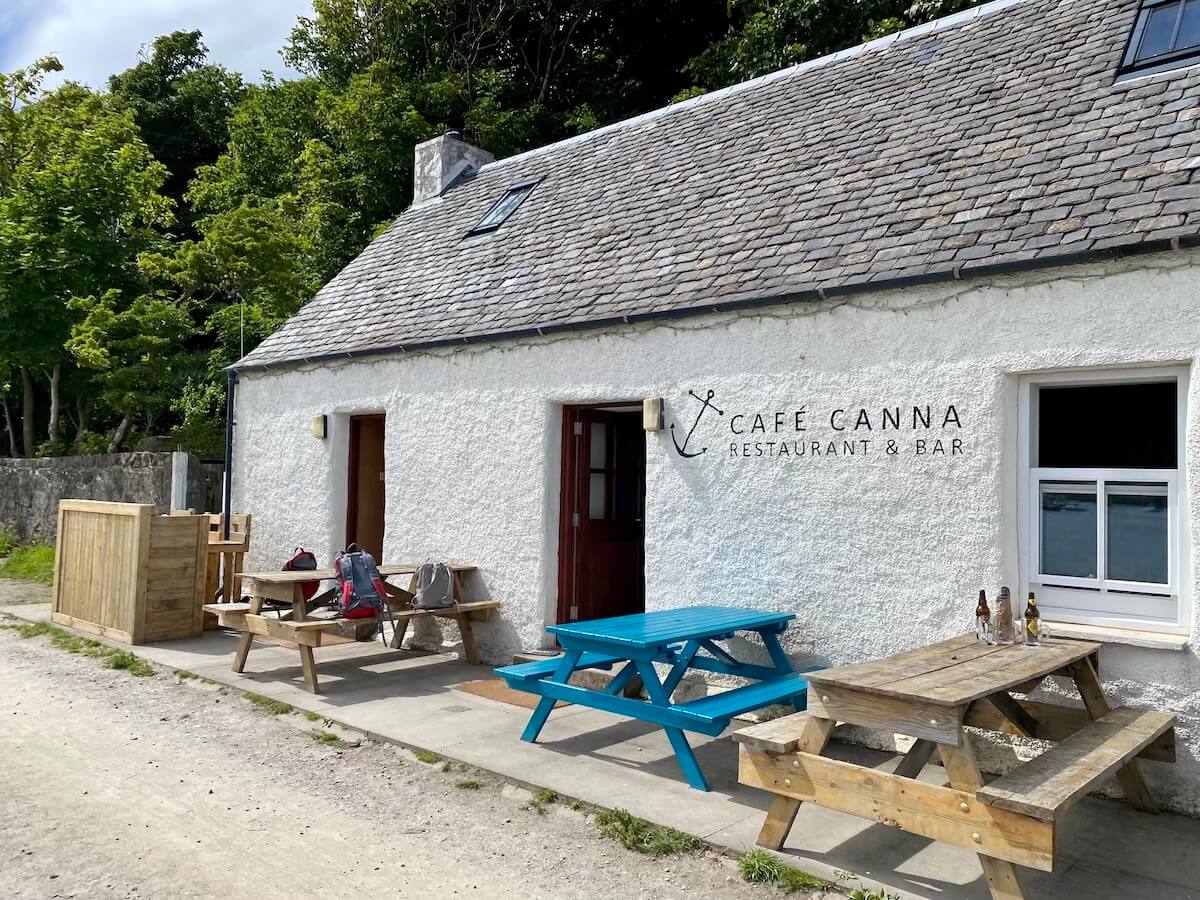
As it is also the only place to eat during the summer months, I recommend you book in advance to ensure a table. We booked for dinner two days before; the only available slot was 6pm. For late breakfast, we were able to turn up without a booking. Keep in mind that they close on Tuesday.
If you’d like to try the lobster or crab, book that as far in advance as possible too. I had requested lobster in advance, but unfortunately, the fisherman hadn’t caught as many as hoped that afternoon, so it was a case of first booked, first served.

For dinner, we ended up ordering three dishes for two of us (blaming the teen for this one!) We had a pint of langoustines, foraged kelp miso ramen, and the Galway Beltie burger and an extra serving of bread and smoked foraged dulse butter to start and everything was delicious. Sadly, I was too stuffed to order the wild gorse flower crème brûlée as planned.
For breakfast, we had delicious peat-smoked salmon and local scrambled eggs on toast from the lunch menu. They were the best scrambled eggs I’ve had!
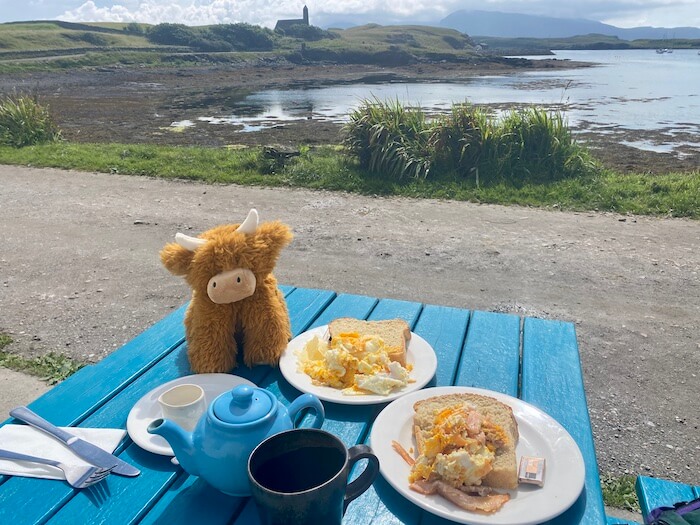
While there, you can browse the books on the shelf, catch up on your messages on their wi-fi or sit outside and enjoy the gorgeous view over the bay.
Sometimes they have events and live music on the last day and we enjoyed a performance by a young Gaelic band who arrived on the ferry. The band members had staff, residents and visitors up doing the Dashing White Sergeant on the coast road and it was a fantastic ending to our trip to the Isle of Canna.
To see more of the Canna cafe and restaurant and make a reservation, visit the Cafe Canna website.
When Cafe Canna closes for the winter, Tighard Guest House opens up to bookings for meals.
Coroghon Castle, Black Beach, Prison Rock
In stark contrast to Sanday Beach is Black Beach next to Prison Rock. Although it’s not instantly recognisable as a black beach, under the mix of salt, etc. is dark grey volcanic sand.
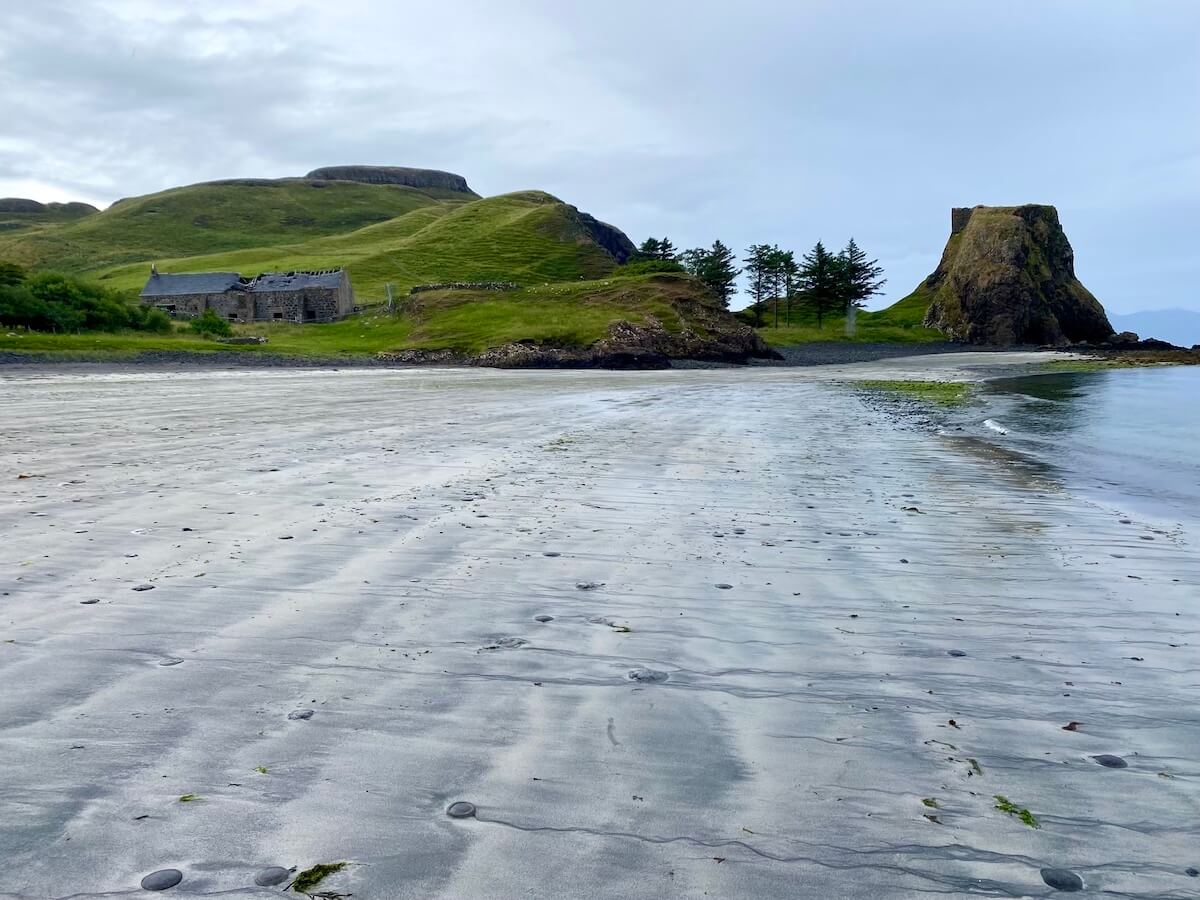
Standing high above on a stack is the remains of Coroghon Castle. It is believed to have been built some time in the 16th-17th centuries. Despite the title of castle, it wouldn’t have been very big and not much is left.
It is also known to some as Prison Rock and it’s thought it was used as a prison in the 17th century. Unfortunately, it’s not safe to climb up but you can see it more closely from up on the grassy path.
From this point, you can go back along the beach or by the grassy path to the old barn or you can take a detour to Saturnino’s Path. (See below.) A further option is to walk along the grassy path to the rocky shore of the east coast.

Saturnino’s Path
You can join Saturnino’s Path either by taking the trail starting behind Canna House or starting at the other end near Coroghon Castle and Compass Hill.
To start near Canna House, you can take the little path going up from the shop. This will take you up along the wall of the house and from there, you can go east on one of the two trails. The upper one goes through the woods and the lower one goes alongside the woods.
If you take the path left, you’ll go behind Canna House and get a glimpse of the gardens and then circle round. The second path left leads to Tighard House.

I did this path in the opposite direction after crossing the field from the radio mast near Coroghon Castle. The easier route is through the low-lying part of the field but there are great views if you cross the higher part. It’s a little bit steep coming down.
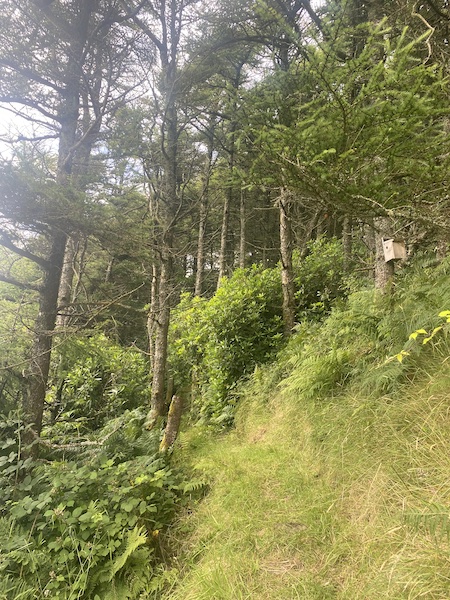
Compass Hill
Compass Hill offers a panoramic view of the surrounding seascape, nearby islands, and the diversity of Canna’s landscape. Sadly, I didn’t have time to make the climb, but you can get there by following Saturnino’s Path above and then, from the end, following the fence through the field up the hill.
The Isle of Canna Souterrains and the King of Norway’s Grave
With a rich history, Canna has many archaeological sites across the island. Among the most intriguing is the souterraines, two ancient underground chambers. While there is speculation, no one knows their purpose or exactly how old they are. However, they are thought to be around 2000 years old.
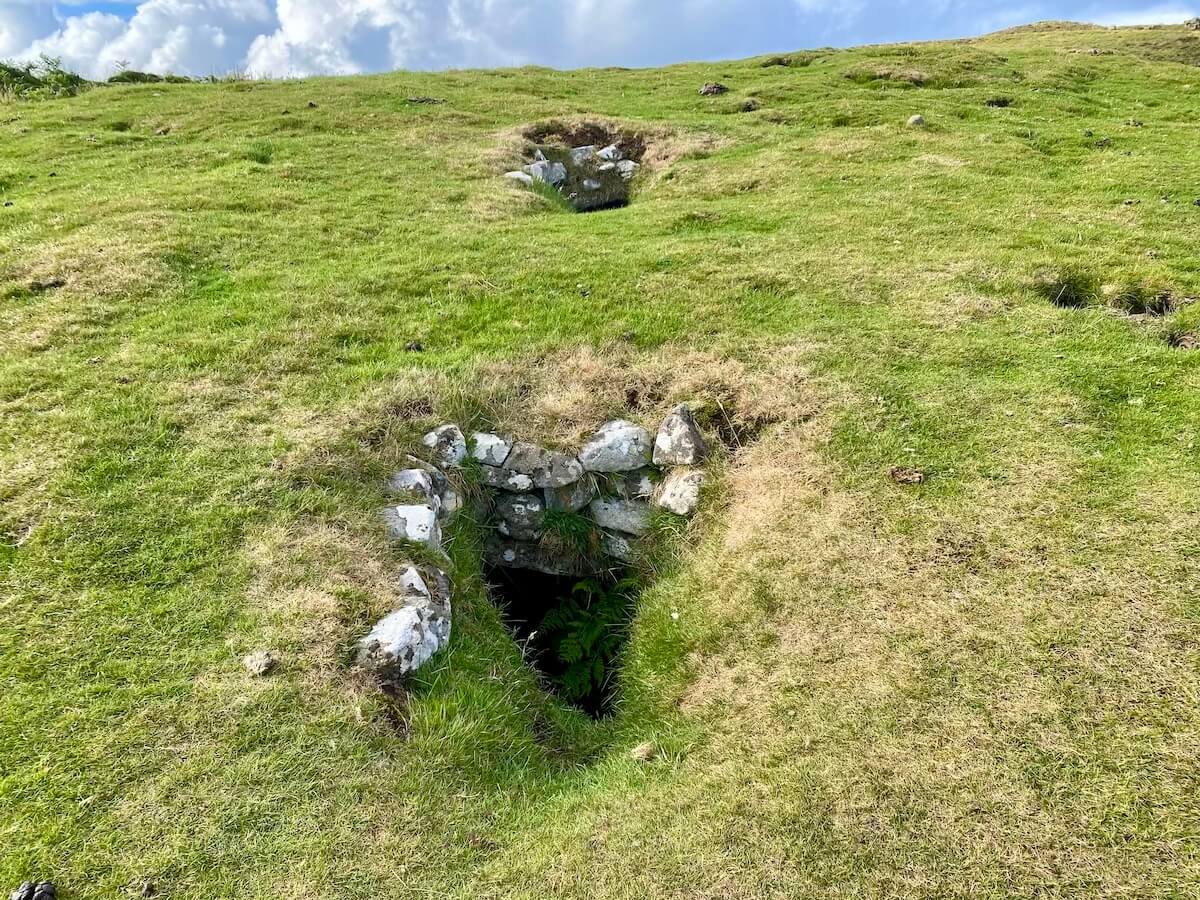
To reach the souterraines, walk along the coast road beyond the campsite and towards Tarbert. After a steep climb and a slight descent, take the turn on the right signposting the trail to the souterrain chambers. Follow the red markers across grassy and, at times, marshy terrain until you see the souterraines in a grassy field on your right.
If you have time, continue toward the northern coastline to look for what is said to be the King of Norway’s Grave on grassland below the cliffs. This path is not marked and you’ll have to cross an open field to get there.
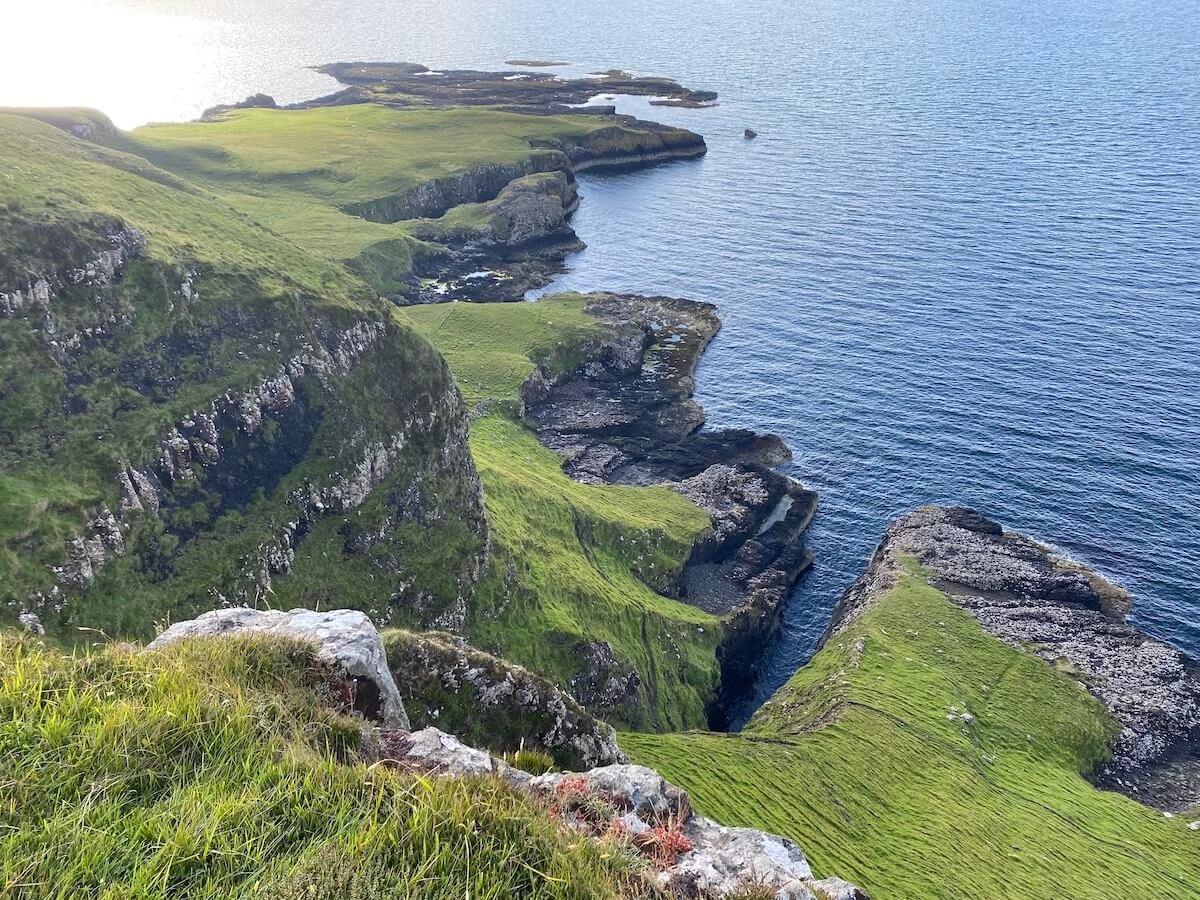
The Isle of Canna website suggests that those who are more adventurous could walk around the north coast to the east and back to Cafe Canna. I didn’t try it myself but I did walk around the east coast to the north and there were lots of large rocks to clamber over.
It was doable but you definitely need a good balance. The larger rocks were better to climb over as they are much steadier than the smaller ones.
If you are not going to explore the west of the island, I recommend at least walking a little further beyond the turn off to the souterrain chambers. There is a stunning view of the coastline, Sanday and the Isle of Rum as well as a couple of very small but beautiful white beaches. The challenge, though, is how to get to them.
Other landmarks along the Canna coast road
After the cafe, you’ll also pass the island telephone box and the post office. Don’t miss the Canna Kitchen honesty shop next door selling delicious home-made jams and chutney. I recommend the chilli and rhubarb and ginger jams!
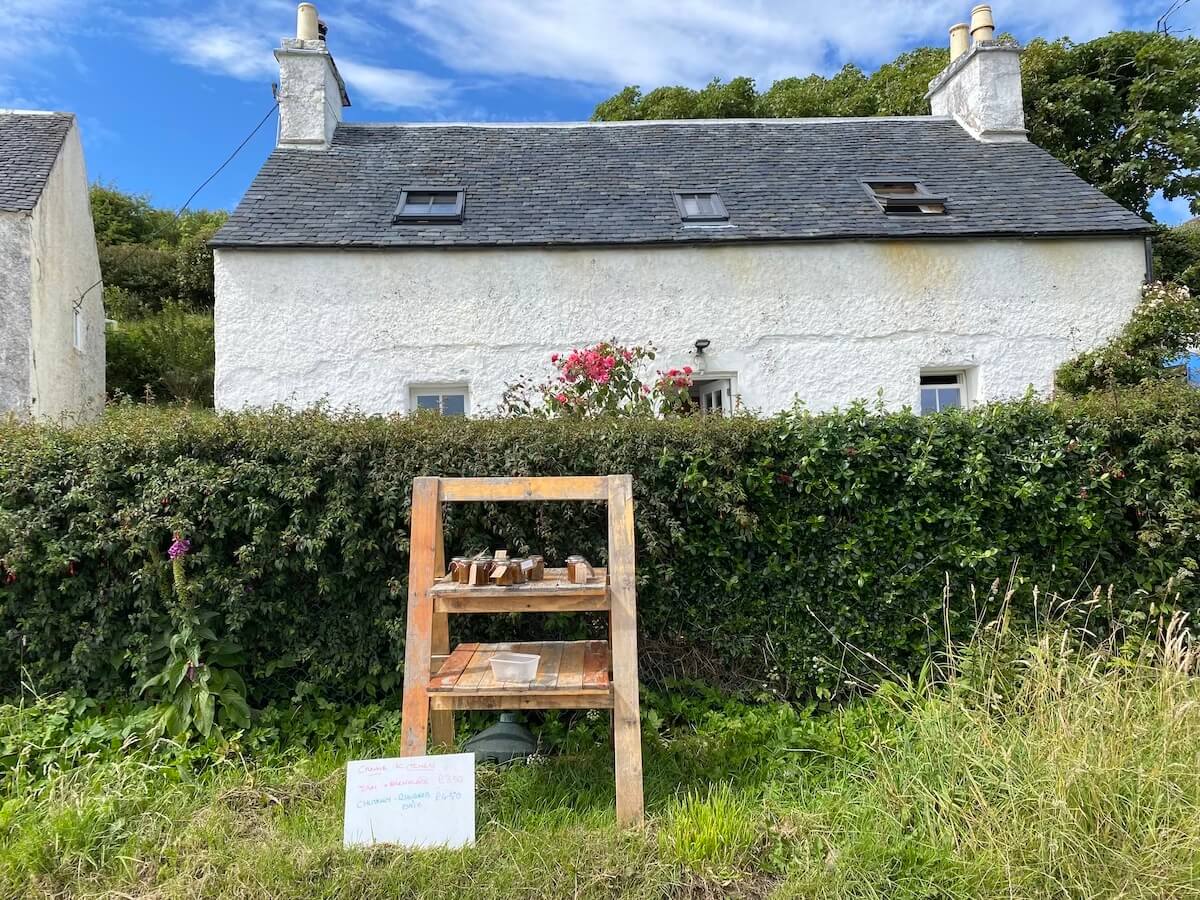
Then, next to St Columba’s Church, look out for the millstone in what was the flour mill and also the Smiddy, or blacksmith’s forge. Keep walking and you’ll come to The Square. Look out for old dairy equipment on display and see if you can work out what they were for. Off the square is The Shearing Shed, which is also a venue for ceilidhs and the like.
Canna Cat Trail
Look out for the Canna Cats along the way. The twelve decorated stone cats were a project initiated by Canna House archivist Fiona. You can find some alone and others in small groups. How many can you find? Read more about the project here. Here are a couple with my Highland cow I bought on the ferry!
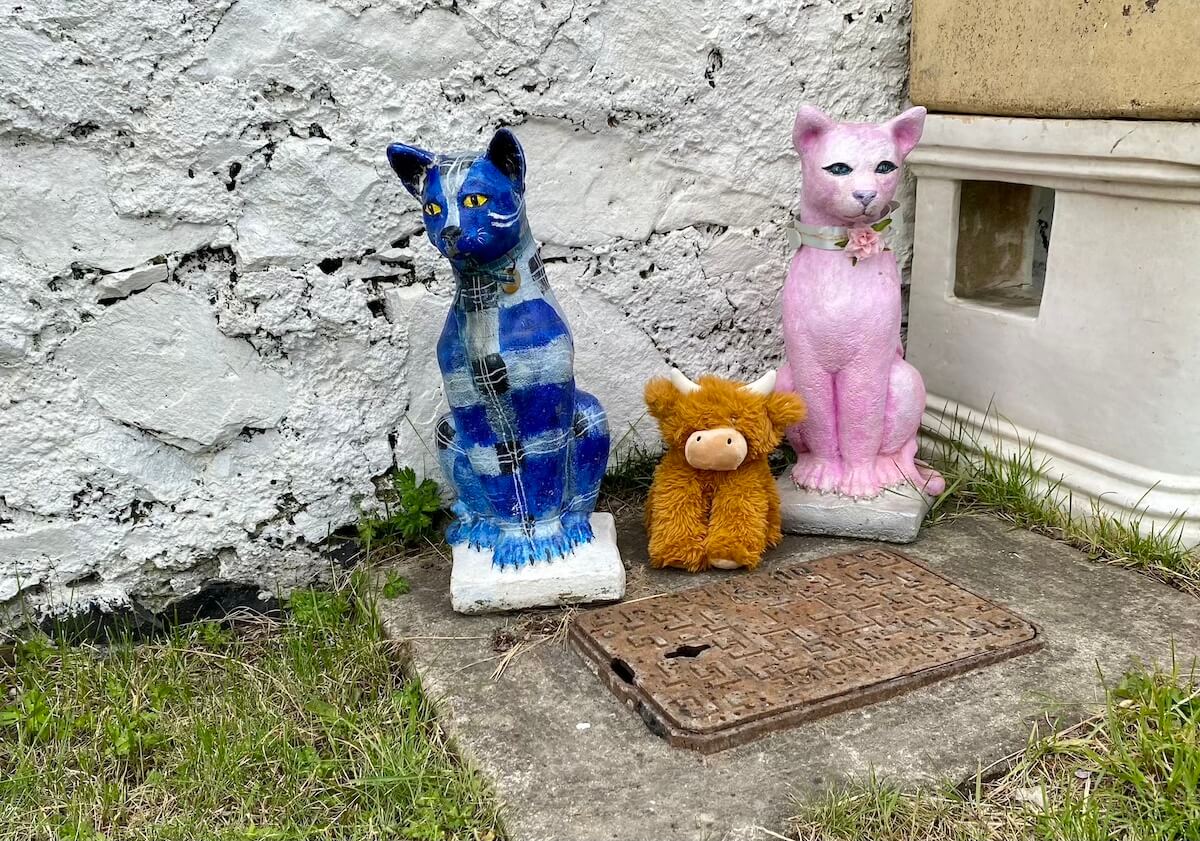
Western side of Canna
I didn’t have a chance to explore the western side of Canna island this trip, but here are a few things of note. Most are ruins and can only be seen from the cliffs above unless you’re kayaking around. Some, like the monastery, are easily discernible, others not so.
Going west along the south coast, the first fort remnants you’ll pass are Dun Rubha Nic Eamoin. About a third of the way along, there is a grassy land jutting out into the sea where the remains of a monastery or nunnery can be seen.
On the Western side, you’ll pass Dun Chanaigh or Canna Fort, Garrisdale Point and on the north coast, Conagearaidh Stone, a standing stone about a metre high. You’ll also see remains of settlements abandoned or destroyed in the Highland Clearances.
You could include this if you have more time on the island and enjoy long walks. If you’d like to walk all round the coast, here’s a useful link on the Canna Coastal Circuit.
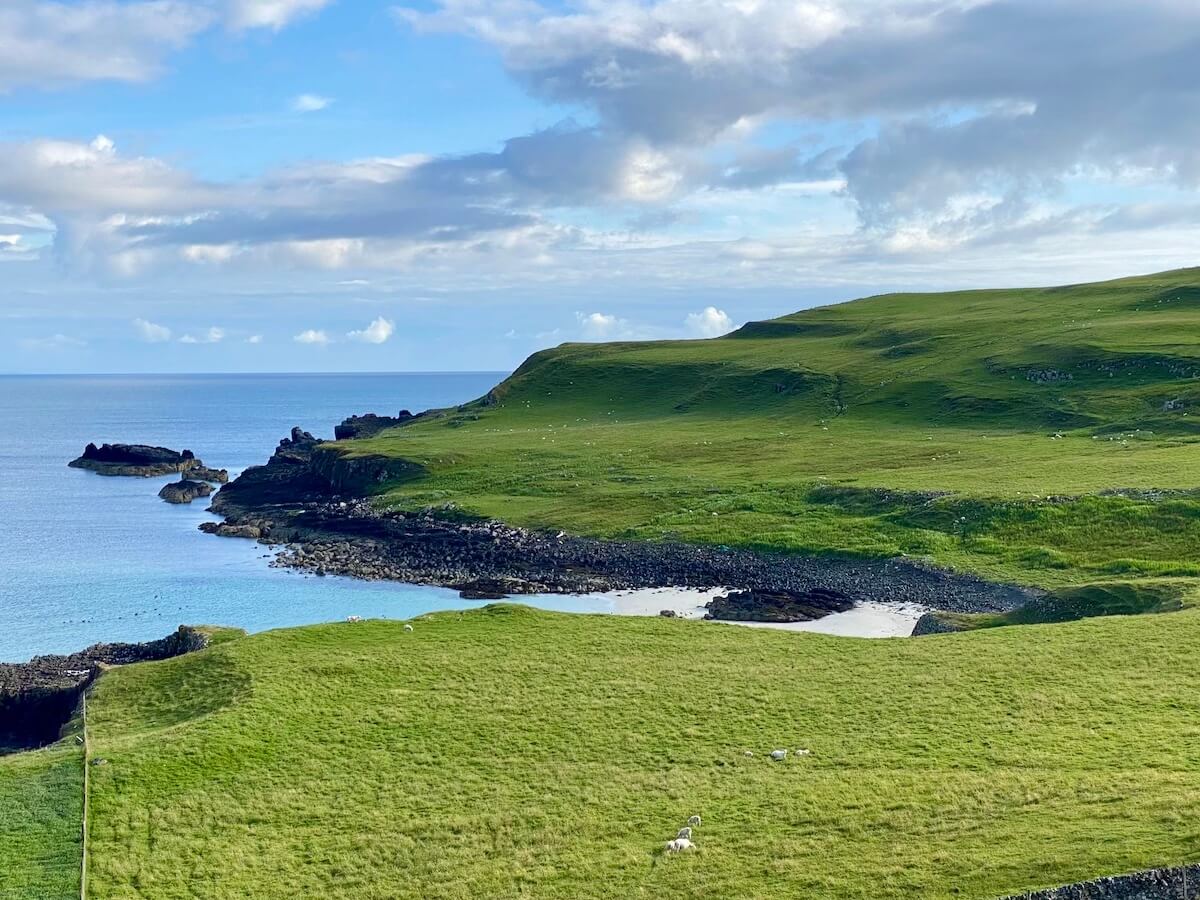
Flora and Fauna on the Isle of Canna
The Isle of Canna offers a rich wildlife experience. As well as puffins nesting there, its cliffs are home to other seabird colonies, including razorbills and guillemots. You may even have to duck for an Arctic Skua. Buzzards are a frequent sight but look out for sea eagles too.
The surrounding waters are home to seals, otters, porpoises and dolphins. On the boat trip to Canna, you might spot a minke whale, orca or even a basking shark.
Canna’s meadows and woodlands also support a variety of butterflies and bees, particularly in the summer, and moths too.
Farm animals include several breeds of cows, including Highland cattle and also some rather large sheep. You can follow Isle of Canna Farm on Facebook to see some of their animals.
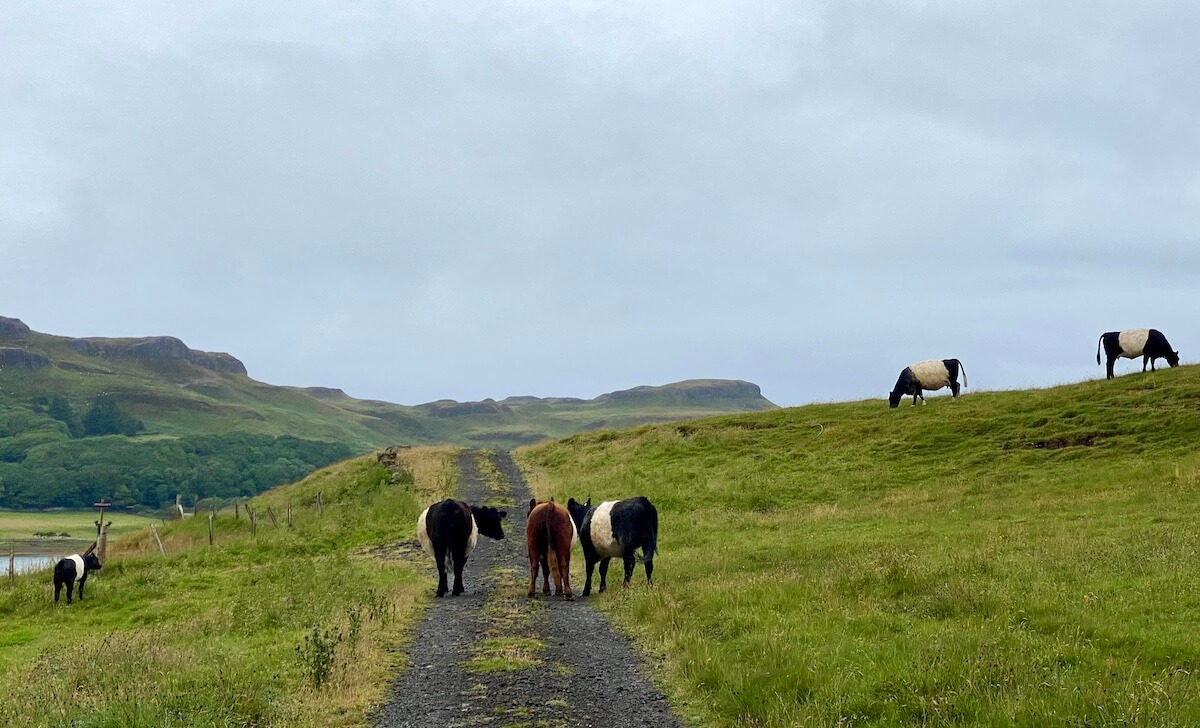
Canna Shop
There is one shop on the island and it’s open 24 hours a day, operating on an honesty basis. You can pay with both cash and card after writing your purchases in the log book or you can also pay online.
It’s small but fairly well-stocked with frozen meat and fish, pasta, noodles, condiments, tinned food, coffee, drinks, sweets, ice-cream and some fruit and veg. They also stock a few books, gifts, plasters, toiletries, etc.
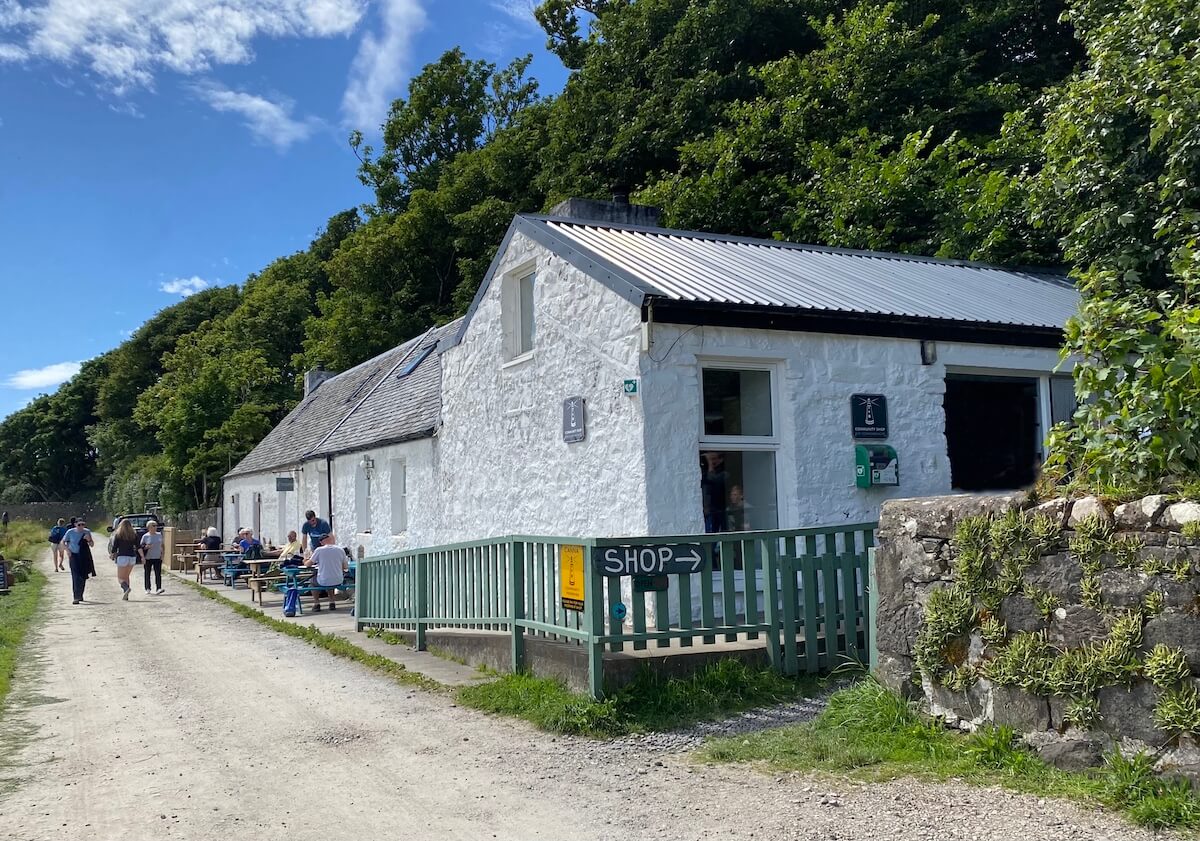
You can pick up some free leaflets published by the National Trust of Scotland, including a map/guide and a couple of suggested walks and a bird guide. You can make a donation in the box or on the website to support their work.
Finally, you can make yourself a cup of tea, coffee or hot chocolate before you go.
Getting Around Canna
Keep in mind when planning what to do on Canna that you’ll have to walk everywhere. You could also bike or kayak but you’ll need to bring your own. Make sure you book ahead and book them onto the ferry in advance.
If you’re planning to do some hill-walking on Canna and the nearby islands, buy OS Explorer Map of Rum, Eigg, Canna and Sanday.
Isle of Canna Accommodation
Moving on to where to stay on Canna Island, the options are few but range from camping to a comfortable stay in an Edwardian house.
Let’s start with Canna Campsite. The options on the site include wooden pods or pitching your tent but they also run the bunkhouse, two caravans and a cabin.

The bunkhouse is a cottage which sleeps eight on bunkbeds in a 6-bunk room and a two-bunk room. The facilities include a shared toilet, shower and kitchen and a wood stove burner. You can book individually or also book the whole house. Access to a washer/dryer is available. You may come across the bunkhouse referred to as Kate’s Cottage.
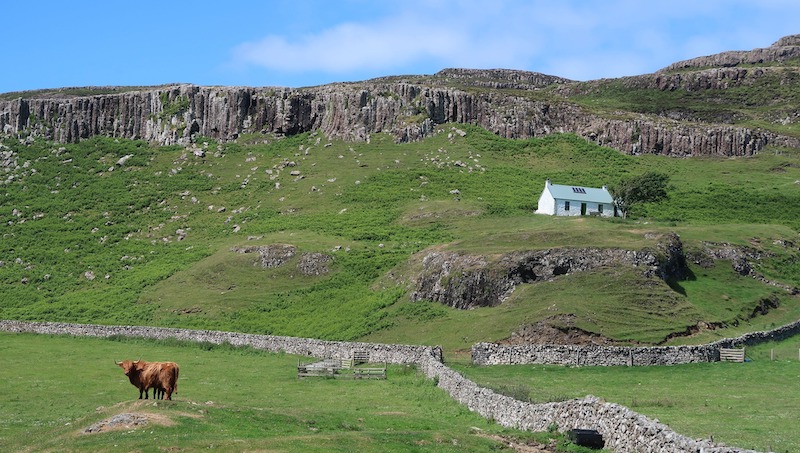
There are two caravans, one on Canna and one on Sanday. Both accommodate up to six and have gas and electricity, a kitchen, toilet and shower and a small garden.
As soon as I saw the cabin on Sanday on our way to see the puffins, I knew I wanted to stay there one day! If you don’t want any neighbours on your holiday retreat, this one is for you. The open-plan cabin sleeps two and has a kitchen and a separate shower and toilet. There’s also a little deck to sit and enjoy the view or read your book while listening to the main different bird calls in the area.

The campsite area itself has areas to pitch your tent and three pods. Facilities include a toilet and shower block and an open kitchen.
The Puffin Pod sleeps two and the Eagle and Otter Pods sleep up to four. All have double futons with very comfortable mattresses. Each pod has a picnic bench. Although you may see sockets in photos, there is no electricity in the pods, so remember to pack a torch or lantern.

The shared kitchen is open on one side, with gas rings, a kettle, and all the utensils you need. The water supply and sink are outside. You’ll need to bring your own cooking supplies though. You can buy meat, veg, milk, coffee, etc. in Canna Shop.
If you book the bunkhouse or pods, bedding and towels are not included in the price. However, if you’re not a backpacker travelling with your sleeping bag, you can pay £15/25 for a single/double bedding set. The goose feather duvet was wonderfully comfortable, so I highly recommend it for a bit of luxury and cosiness.
When you book, you can opt to pay for the use of the cooking ring (£5) and fire logs (£8). If you forget or change your mind, you can pop some cash in the honesty box.
They also offer a free luggage pick-up and drop-off service to and from the pier. You can find out more and book your stay on the Canna Campsite website.
If you prefer a bit of luxury, consider booking Tighard Guest House. The only other big house on the island, the Edwardian home sits on the hill above Canna House amidst lush gardens.
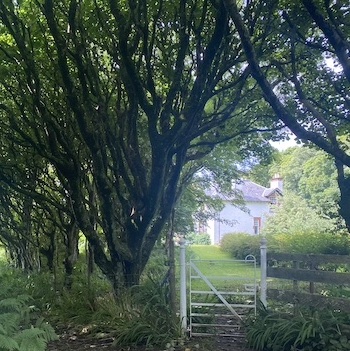
It offers three rooms with private bathrooms and a shared lounge. Breakfast options include full Scottish or porridge. You can also book dinner at an extra cost. Visit the Tighard Guest House website to see more or make a reservation.
Finally, on Sanday are three fully-equipped self-catering cottages, each with a private garden and a view across to Canna. The renovated croft houses are right on the shore, making them an excellent option for kayakers. See more or make a reservation at the Canna Self-catering website.
Where we stayed on Canna
I chose to book the Puffin Pod at Canna Campsite and it didn’t disappoint! Aiming to recreate my own childhood holiday experiences for my teen but also concerned that it would pour the whole time, I opted for the dryer option of a pod rather than a tent. Not being well enough organised with sleeping bags, I added the bedding option at the last minute.
Although the pod itself was basic, lying on a comfortable futon mattress with a luxurious goose-feather duvet looking out to the white beach of Sanday, the turquoise sea and the mountains of Rum in the background was delightful! Even when it was raining!
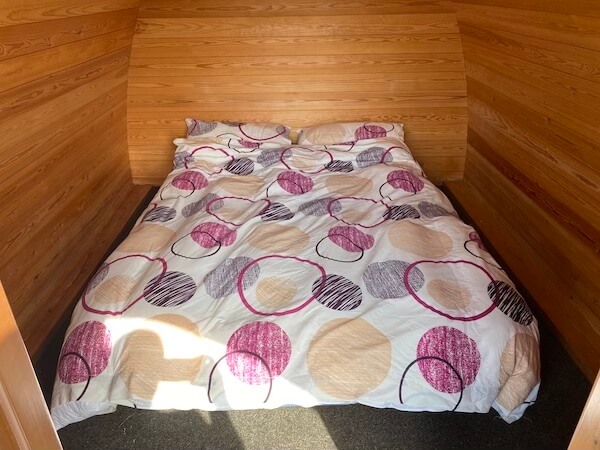
Once it started to get a bit cold outside, we closed the doors and pulled down the blackout blind and it was nice and warm. We had heavy rain overnight and it was definitely waterproof.
The toilets and showers were a slight trek but not further than any other campsite. More importantly, they were clean and in good condition with toilet rolls, etc. provided.
Would I stay in the pods again? Absolutely!
How long to stay on the Isle of Canna
How long you should stay on the Isle of Canna depends on what you want to do there. For many, a trip there will be part of a tour of the Highlands and Islands. In that case, you’re probably also limited by ferry crossings and minimum stays.
The shortest stay using the ferry and Canna Campsite is two nights and you can see a lot in that time but three nights would be better.
However, if you’re looking to spend time both relaxing and exploring the island as much as possible, a week would work well too. There are plenty of walks in Canna to go on a different one each day. You could stay longer if you have a pile of books to read or enjoy painting. It would be the perfect retreat to go and start on that book you’ve been meaning to write all these years with minimum distractions.
Go back to the top or What to see and do in Canna
Best time to visit the Isle of Canna
The summer months, with the long days, are the ideal time to visit the Small Isles. April to August is popular as the puffins gather on the stack on neighbouring Sanday. September and October brings beautiful autumn colours on the hills.
In the winter, the cafe closes, and the island is very quiet, with few folk around. However, that may be the perfect time if you’re looking for a retreat.
You might like to go when there’s an event on like the ones below. Look out for ceilidhs or visiting musicians. The best way to know about events on Canna is to follow the island’s own social media accounts and to visit their website. Find the Isle of Canna Community on Facebook and on Instagram.
Canna 10k – island trail running
One of the most anticipated events is the Canna 10K, a race that challenges participants with its rugged landscapes and rewards them with some of the most breathtaking views.

Runners from all over make their way to the island every year to tackle the course, making their way through winding trails, historic sites, and coastal paths.
Even if you’re not participating in the race, you can go along to the ceilidh in The Sheering Shed in the evening. Make sure you brush up your Scottish dancing skills before you go and I can guarantee a fun time will be had by all!
The next race will be on 24 May 2025. Find out more about the Canna 10K here.
Wild Running and Seafood Retreat
On the 20th to the 23rd of September 2024, a four-day running and seafood retreat will take place on Canna. This one is for ladies only.
What to pack for a trip to Canna
As an Amazon Associate, I earn a small commission from qualifying purchases. I only recommend products that I use myself or that I have researched.
I recommend waterproof boots unless you’re only planning on hanging around the bay, such as on a short day trip. However, if you’re staying for longer, it would be a pity to miss more of the sights.
If you have binoculars, definitely bring them. If you don’t, maybe now is the time to consider buying some. As there is no public lighting and almost zero light pollution, a torch is handy even if you’re not camping.
If you’re going for walks anywhere in the countryside here, I recommend long trousers, socks and boots or closed shoes. They’ll give you a degree of protection against all sorts – ticks, midges, stinging nettles, thorny plants such as gorse and thistle.
Ticks have been on the increase recently and you should always check yourself when you’re staying in the countryside. Hopefully, you won’t get any but you should always check yourself and have a means to remove them.
You can buy tick-remover cards or tools at a chemist (drugstore/pharmacy) or order a tick-removing tool online. Personally, I prefer tweezers but you need to use pointed tweezers and be sure to remove the whole body. I recently bought this tick removal set after going through user reviews of different tools.
Even if you don’t go for walks, you should still check daily. Don’t panic though. Catching them early eliminates the risk of complications. Read more on my post on Ticks in Scotland.
We were fortunate not to see any midges on our trip but Smidge is always good to pack for trips in the Scotland! You’ll find it at several shops and petrol stations on the drive up to Mallaig, in Canna Shop or you can order it online here. Calendula candles can also help keep midges at bay if you’re sitting outside.
If you’re opting for the pods or camping, pack a power-bank so you don’t run out of battery to take photos of all the beautiful scenery and to be able to use maps if needed. (This is a useful one for camping.)
A small first aid kit can be useful, particularly when you’re staying in remote places. You can buy plasters and a few other things at the island shop. Pick up a kit at the chemist before going or order one online. At the very least, pack a few plasters and antiseptic wipes. Don’t forget sunscreen.
As for any holiday in Scotland, pack layers! You could be sweltering in a t-shirt one minute only to have your sweater and waterproof jacket on the next. Jeans, t-shirts, hoodie and a light waterproof jacket worked for us. Add some shorts or light trousers for relaxing if you’ve got room and a swimsuit and hat.

If you’re staying at the campsite and travelling with friends or family, pack a travel game or two or a pack of cards for the evening or rainy moments. (We weren’t prepared for this and ended up inventing games using Minstrels!)
Other things to consider are notebooks and books. See some recommended reading below. Some of these will be available in the island shop but I recommend getting a guide beforehand to help plan your trip. (Basing that on my own mistake of not doing it!) On the same note, print off, download or screenshot relevant online info before you leave the digitally-connected world behind.
If you want a good map for walking, buy the OS Explorer map of Rum, Eigg, Muck, Canna and Sanday or subscribe to the OS mobile app Remember to download them before leaving the mainland.
Don’t forget some cash for honesty and donation boxes and maybe tips too. The last cash withdrawal machine before Canna is at Mallaig.
Sustainability on Canna
Sustainable practices and plans for growth are at the heart of the Canna community. The island runs almost entirely on renewable energy using a hybrid system of wind, solar and battery storage. Scotland rarely lacks wind, however, when sun and wind are both in short supply, backup diesel generators fire into action.
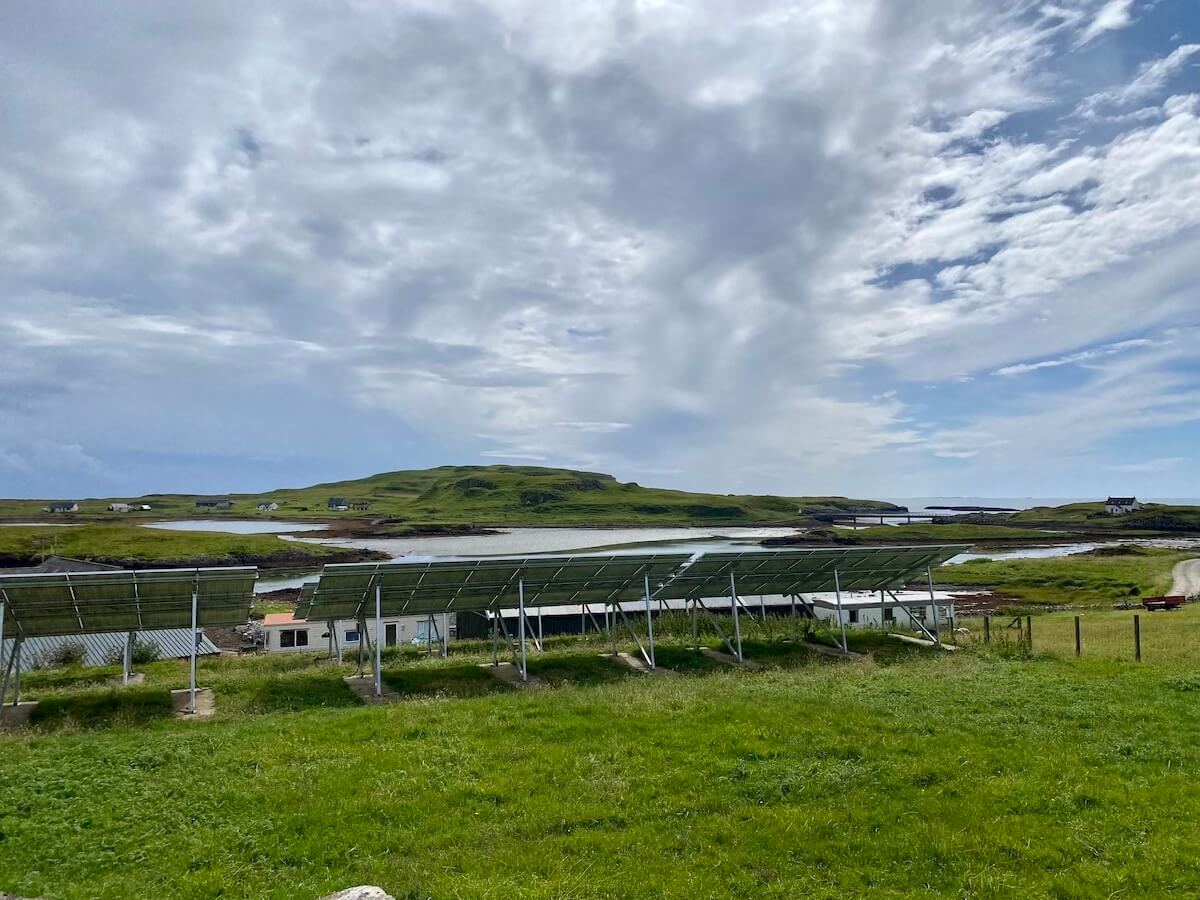
Local and sustainable food sources are used as much as possible, for example, in the restaurant and shop and eco-tourism is high on the agenda.
At the helm of these initiatives is the Isle of Canna Community Development Trust, which manages community assets. Successes already include setting up the community shop and mooring and fund-raising for community housing is underway to increase the tiny population.
Meanwhile, the National Trust of Scotland is working to preserve the local Gaelic heritage through their work at Canna House and protecting the farmland and local wildlife,
It will be exciting to see what the future of Canna as a sustainable community and destination brings.
Recommended reading – books about Canna
As an Amazon Associate, I earn a small commission from qualifying purchases. I only recommend products that I use myself or that I have researched.
- Guide Book – Coll, Tiree and the Small Isles, Inner Hebrides by Paul and Helen Webster- buy now on Amazon
- The Man Who Gave Away His Island by Ray Perman – This is the story of John Lorne Campbell of Canna who gave away the island to the Scottish National Trust. You can buy this in the island shop or if you’d like to read it before, buy the paperback or Kindle edition on Amazon.
- Canna: The Story of a Hebridean Island by John Lorne Campbell Available in various formats.
- From the Alleghenies to the Hebrides: An Autobiography – the autobiography of Margaret Fay Shaw, wife of John Campbell. Buy here.
- If you’re planning on lots of walking on the Small Isles, an Ordnance Survey map be useful. You can buy the Rùm, Eigg, Muck & Canna Map locally or order online.
- If you wish to dig deeper into the history of Canna and the neighbouring isles, you may like to read The Small Isles: Canna, Eigg, Muck and Rum by John Hunter. Buy KIndle edition here.
If you loved the food at Cafe Canna, you can buy a Cafe Canna recipe book, Cafe Canna: Recipes from a Hebridean Island, there. You can also order it on Amazon.
Wrap-up on visiting The Isle of Canna
And now the final question – would I recommend a visit to Canna? I would definitely recommend it to friends who like hill-walking, nature, good food and need a break away from a busy everyday life. I had a fabulous time there and hope to go back soon and explore the parts I missed.
I hope you enjoyed this Canna Travel Guide. For more information, visit the Isle of Canna website. I also created a digital download of this guide just because I wish I’d had one! It would have been very useful as we had no internet. You can buy it in epub, MOBI and PDF for a small fee right here and it includes maps and checklists.
If you are continuing your holiday in Mallaig, Morar or Arisaig, please visit my home page to see more and you can see a glimpse of the Isle of Eigg here, more on the Isle of Rum and other boat trips from Mallaig and Arisaig here.
Do you have something to contribute?
Have you visited the Isle of Canna? Maybe you volunteered or lived there? Share your own experiences and tips in the comments!
Follow on Instagram or Facebook to see more photos, videos, tips and snippets of information.
FAQs About Canna Island Scotland
- Where is the Isle of Canna located? Canna Isle is located in the Inner Hebrides of Scotland, off the west coast of the Scottish mainland.
- How can I get to the Isle of Canna? You can reach the Isle of Canna by ferry from Mallaig, a port on the Scottish mainland. The ferry service is operated by Caledonian MacBrayne and runs regularly, weather permitting. See article above for more info
- What are the main attractions on the Isle of Canna? The Isle of Canna offers stunning landscapes, historical sites, walking trails, wildlife watching opportunities, and a chance to experience traditional Scottish island life. Notable attractions include St. Columba’s Church, Compass Hill, and the Canna House.
- What is the best time to visit the Isle of Canna? – The best time to visit the Isle of Canna in the Hebrides depends on your interests. Spring and summer offer milder weather and blooming landscapes, while autumn provides opportunities to see migratory birds. Winter visits can be enchanting but come with the risk of unpredictable weather.
- Is the Isle of Canna suitable for families? – Yes, the island offers various family-friendly activities and attractions, such as hiking, wildlife watching, and exploring historical sites.
- Can I bring my dog to Canna Scotland? – Dogs are typically welcome on the isle Canna is run as one large farm, so check specific regulations and also, accommodation policies.
- Are there dining options on the Isle of Canna? – Canna Café is open during high season, except Tuesday and when it closes, dinner is available at Tighard guest house. Visitors should consider self-catering.
- What wildlife can be spotted on the Isle of Canna Scotland? – The Isle of Canna is home to a variety of wildlife, including puffins from March to July, seabirds, seals, whales, and dolphins. The island is a great spot for bird watching.
- Is the Isle of Canna involved in any conservation or ecotourism efforts? – Yes, the Isle of Canna is part of the Small Isles Special Area of Conservation, and there are efforts to preserve the island’s unique environment and wildlife. Eco-friendly practices are encouraged for visitors.
- Can I fly a drone on Canna Isle? No, it’s not permitted to fly a drone on the Isle of Canna.
- Is Canna Scotland worth a visit? If you love quiet natural places, walking and birdwatching or just looking for a retreat, yes!
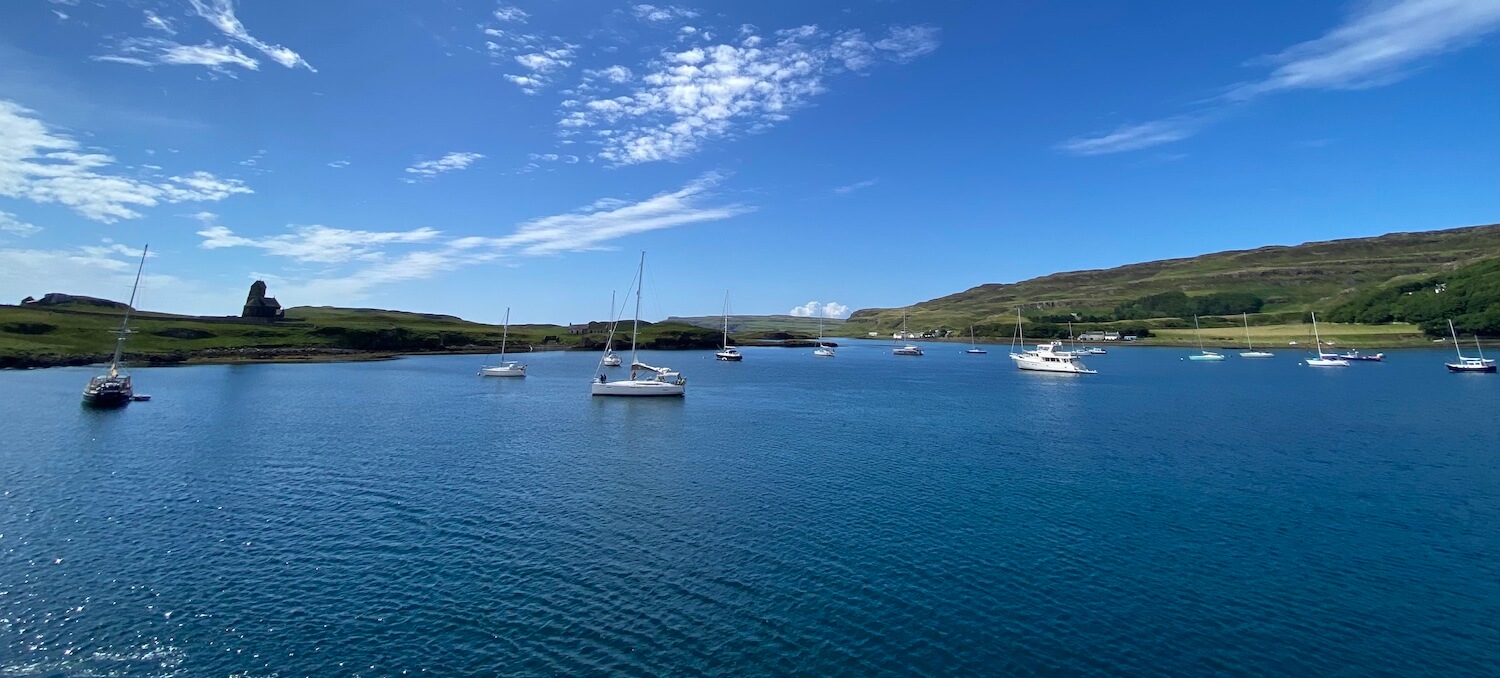
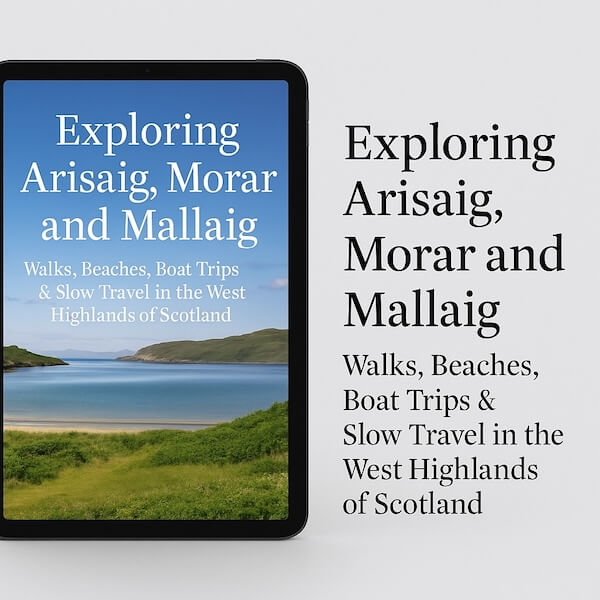
Wow, this place looks amazing. I haven’t heard of Isle of Canna before, but I’m glad that I’ve read your post. Definitely adding this to my Scotland list!
I am pretty sure I have been there on a sailing trip, anywhere in Scotland you cannot access in a car is attractive to me as it is usually quiet and lovely